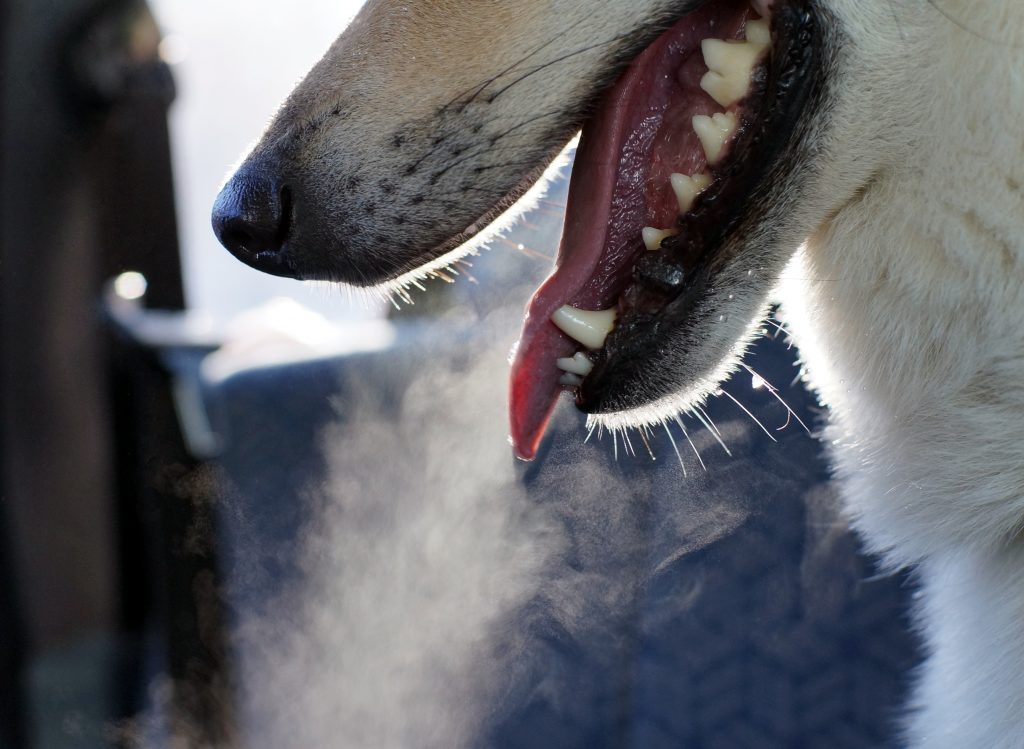Dog Breath! Dental Health for Pets

The health of our pets’ teeth and gums is a component of their care that is too commonly ignored. While most people would never entertain the thought of not brushing their own teeth, they usually don’t think of their pets’ teeth in the same way. Yet, according to the American Veterinary Dental Association, up to 80% of dogs and 70% of cats have some form of dental disease by the age of three. This serves as a reminder that it doesn’t take long for problems to develop when we fail to care for our pet’s teeth, even when they are young.
Without daily cleaning, bacteria in the mouth combine with saliva and food on the teeth and gums, causing a sticky plaque to form. This plaque eventually turns into tartar, a hard, mineralized build up.
Over time, plaque and tartar continue to accumulate, causing inflammation of the tissues around the teeth. This painful process is called periodontal disease and, when left unchecked, it results in both oral and systemic infection, tooth decay and loss of the teeth.
Preventive dental care in pets is very important, and Lone Tree Veterinary Medical Center wants you to understand how routine oral examinations, home dental care, and professional dental cleanings play into your pet’s overall well-being.
Say “Ahhh!”
Chances are that you don’t look inside your pet’s mouth very often. That’s okay, it is our job to perform an oral examination during your pet’s routine wellness visits. It is your job to ensure that these happen, at a minimum, once a year. A good oral examination can alert us to early signs of a problem that can be addressed early on before it becomes a serious and expensive issue.
It is also wise to bring your pet in for a checkup if you notice:
- Bad breath
- Change in eating habits
- Pain when touching the mouth
- Obvious tartar buildup
- Red or swollen gums
- Bleeding or loose teeth
- Drooling
- Swelling of the muzzle
It is common for pets with dental disease to not show obvious signs of trouble, partly because they are good at concealing pain and, because most dental disease occurs below the gum line and only visible on x-rays that show the condition of the roots and jawbone.
It Starts at Home
Dental care at home can be vital in preventing and slowing progression of dental disease in our pets. It also helps you to be aware of your pet’s “normal” and pick up on issues early.
The foundation of home dental care for pets is tooth brushing. While it does take a little time and commitment, most pets tolerate this daily hygiene habit quite well. When it comes to pet tooth brushing:
- Aim to brush daily
- Introduce your pet to the tooth brush slowly, using lots of praise and treats
- Start by rubbing the teeth with a finger, then move to a pet-specific toothbrush when your pet is ready
- Keep brushing sessions gentle and short – you only need to brush the outer side of the teeth — it should take less than a minute to brush both uppers and lowers
- Only use a pet-specific toothpaste containing enzymes to break down plaque — these come in different flavors, so you can find one that your pet likes
- Do not use human toothpaste, as it contains ingredients that are toxic to pets, including, fluoride or Xylitol
- Remember, it is common for pets to lick the toothpaste and toothbrush while you’re brushing, so don’t let this distract you
- If your pet won’t tolerate brushing, don’t push the issue but do be patient, as many pets will get used to it over time
There are a myriad of pet dental care products on the market that include chews, treats, rinses, and even prescription dental diets. While these may help some, they do not replace brushing and professional routine care at our facility. Some products are better than others, as well. Check out the Veterinary Oral Health Council’s list of products that have been shown to be beneficial in pet dental health.
Our Role in Dental Health for Pets
Even though we brush our teeth, we still need to visit the dentist. Pets also require comprehensive dental examinations and through cleanings throughout their lifetime.
In depth exams and cleanings do require the pet to be under general anesthesia. This allows us to examine the entire mouth, probing the teeth and obtaining dental radiographs in order to gain a full assessment of your pet’s oral cavity.
After this assessment, the teeth are scaled on all surfaces and under the gum line in order to remove plaque and tartar. They then can be polished in order to remove microscopic grooves and a fluoride treatment is also applied. During this anesthetized examination, any diseased or painful teeth can be extracted or other recommended treatments performed.
Pets are different and will need an anesthetized examination and cleaning at different intervals. We can make a better assessment and recommendation for your individual pet during your wellness visits.
Dental care for pets is important, as dental disease is very common and can be quite debilitating. Untreated, it can decrease your pet’s quality of life and shorten his or her life expectancy by years. If you need help getting your pet’s dental health on the right track, don’t delay. Give us a call today. It’s always a good time to give your pet’s oral health a fresh start!

